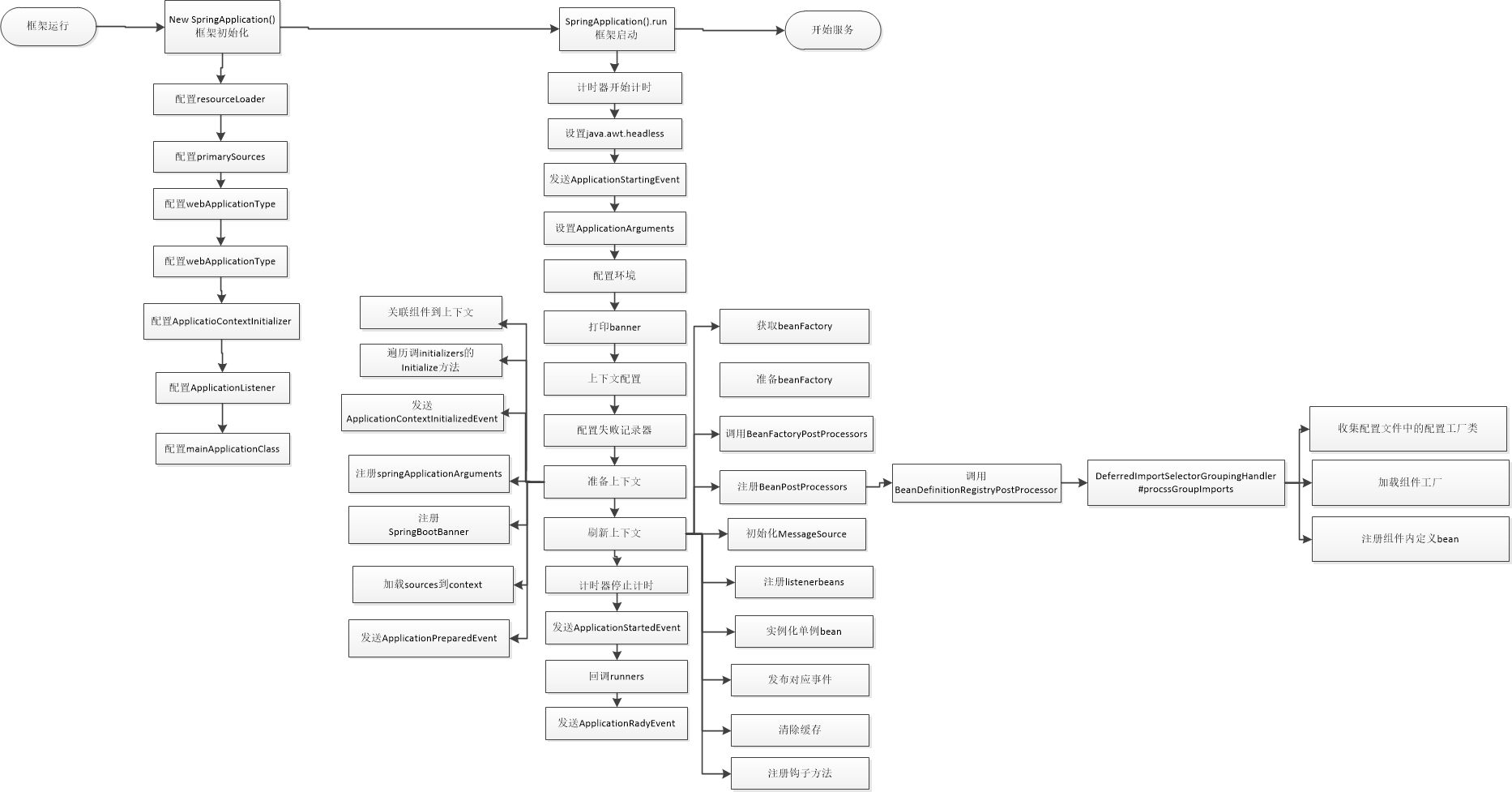一、一行代码完成启动
@SpringBootApplication
public class Sb2Application {
public static void main(String[] args) {
SpringApplication.run(Sb2Application.class, args);
}
}
进入SpringApplication的run方法
SpringApplication.run(Sb2Application.class, args);

分为两步: 一步是初始化SpringApplication, new SpringApplication,第二步是调用SpringApplication的run方法
第一步:初始化SpringApplication
public SpringApplication(Class... primarySources) {
this((ResourceLoader)null, primarySources);
}
public SpringApplication(ResourceLoader resourceLoader, Class... primarySources) {
this.sources = new LinkedHashSet();
this.bannerMode = Mode.CONSOLE;
this.logStartupInfo = true;
this.addCommandLineProperties = true;
this.addConversionService = true;
this.headless = true;
this.registerShutdownHook = true;
this.additionalProfiles = new HashSet();
this.isCustomEnvironment = false;
this.lazyInitialization = false;
this.resourceLoader = resourceLoader;
Assert.notNull(primarySources, "PrimarySources must not be null");
this.primarySources = new LinkedHashSet(Arrays.asList(primarySources));
this.webApplicationType = WebApplicationType.deduceFromClasspath();
this.setInitializers(this.getSpringFactoriesInstances(ApplicationContextInitializer.class));
this.setListeners(this.getSpringFactoriesInstances(ApplicationListener.class));
this.mainApplicationClass = this.deduceMainApplicationClass();
}
第二步 调用SpringApplication的run方法
/**
* Run the Spring application, creating and refreshing a new
* {@link ApplicationContext}.
* @param args the application arguments (usually passed from a Java main method)
* @return a running {@link ApplicationContext}
*/
public ConfigurableApplicationContext run(String... args) {
StopWatch stopWatch = new StopWatch();
stopWatch.start();
ConfigurableApplicationContext context = null;
Collection<SpringBootExceptionReporter> exceptionReporters = new ArrayList<>();
configureHeadlessProperty();
SpringApplicationRunListeners listeners = getRunListeners(args);
listeners.starting();
try {
ApplicationArguments applicationArguments = new DefaultApplicationArguments(args);
ConfigurableEnvironment environment = prepareEnvironment(listeners, applicationArguments);
configureIgnoreBeanInfo(environment);
Banner printedBanner = printBanner(environment);
context = createApplicationContext();
exceptionReporters = getSpringFactoriesInstances(SpringBootExceptionReporter.class,
new Class[] { ConfigurableApplicationContext.class }, context);
prepareContext(context, environment, listeners, applicationArguments, printedBanner);
refreshContext(context);
afterRefresh(context, applicationArguments);
stopWatch.stop();
if (this.logStartupInfo) {
new StartupInfoLogger(this.mainApplicationClass).logStarted(getApplicationLog(), stopWatch);
}
listeners.started(context);
callRunners(context, applicationArguments);
}
catch (Throwable ex) {
handleRunFailure(context, ex, exceptionReporters, listeners);
throw new IllegalStateException(ex);
}
try {
listeners.running(context);
}
catch (Throwable ex) {
handleRunFailure(context, ex, exceptionReporters, null);
throw new IllegalStateException(ex);
}
return context;
}
二、启动流程
1、框架初始化
2、框架启动
3、自动化装配
1、框架初始化步骤
框架初始化步骤:
配置资源加载器
配置primarySources
应用环境检测
配置系统初始化器
配置应用监听器
配置main方法所在的类
2、框架启动流程
计时器开始计时 -> Headless模式赋值 -> 发送ApplicationStartEvent
-> 配置环境模块 -> 发送ApplicationEnvironmentPreparedEvent
-> 打印banner(打印出来的Spring 1.X 或者Spring 2.X条幅)
-> 创建应用上下文对象 -> 初始化失败分析器
-> 关联springboot组件与应用上下文对象 -> 发送ApplicationContextInitializedEvent
-> 加载source到context -> 发送ApplicationPreparedEvent
-> 刷新上下文(调用Spring框架的DoRefresh方法)
->计时器停止计时 -> 发送ApplicationStartedEvent
-> 调用框架启动扩展类 -> 发送ApplicationReadyEvent
3、自动化装配
收集配置文件中的配置工厂类
加载组件工厂
注册组件内定义bean
Spring Boot的完整流程图
